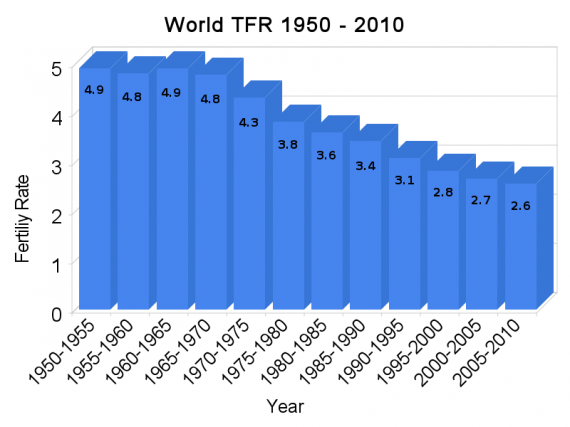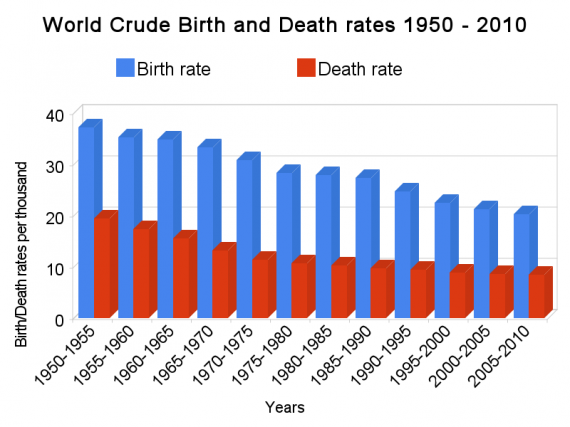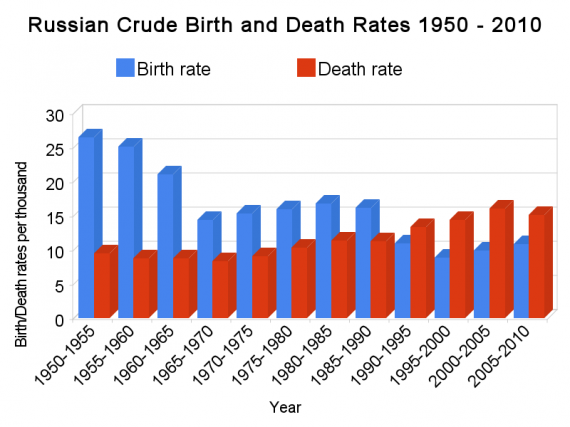In the United States, in these times of high unemployment, increasing deficits, and seemingly endless wars, it would be well to count our blessings. One such blessing is the bounteous land in which we live. The United States has more arable land than any other country. Even though the United States is the third most populous nation on Earth, her Real Population Density ranks as twelfth least dense of all nations.
As the world’s population increases and ever more demands are placed on the food supply, am I thankful to be living in the United States. Let me explain some of the terms associated with real population density and show you the favorable numbers for the U.S.A.
Arable Land
Agricultural area includes land suitable for crops and livestock. The standard classification, used by Food and Agriculture Organization of the United Nations, divides agricultural area into these components:
- Arable Land — land under annual crops, such as cereals, potatoes, vegetables, and melons that are replanted after each harvest; also land left temporarily fallow.
- Orchards and Vineyards — land under permanent crops such as citrus, coffee, and rubber that are not replanted after each harvest.
- Meadows and Pastures — areas for natural grasses and grazing of livestock.
In 2008, the world’s total arable land amounted to 13,805,153 square kilometers, whereas 48,836,976 square kilometers was classified as agricultural land. In this post, we are focused on arable land. Of interest is this map of the world with arable land percentages showing the United States in the 15-19% range.
Real Population Density
Population density is the number of people per square kilometer. Real Population Density is the number of people per square kilometer of arable land. This enables us to see the capacity of a country to feed their own people.
Real Population Density is a much better measure than pure population density as it shows how a seemingly more densely populated country can carry a larger population because a much bigger portion of the land is suitable for agriculture.
For those of us used to thinking in acres, one square kilometer is equal to 247.1 acres.
Table of Countries by Real Population Density
Click ONCE on column headers to sort.
| Rank | Country1 | Real Density2 | Population | Arable Land (km2) |
|---|---|---|---|---|
| 1 | Australia | 48 | 22,268,000 | 468,503 |
| 2 | Kazakhstan | 72 | 16,026,000 | 221,059 |
| 3 | Canada | 82 | 34,017,000 | 415,573 |
| 4 | Niger | 107 | 15,512,000 | 144,784 |
| 5 | Lithuania | 114 | 3,324,000 | 29,216 |
| 6 | Russia | 117 | 142,958,000 | 1,218,599 |
| 7 | Latvia | 126 | 2,252,000 | 17,926 |
| 8 | Ukraine | 140 | 45,448,000 | 324,791 |
| 9 | Argentina | 147 | 40,412,000 | 274,490 |
| 10 | Guyana | 172 | 754,000 | 4,390 |
| 11 | Belarus | 173 | 9,595,000 | 55,575 |
| 12 | United States | 188 | 310,384,000 | 1,650,062 |
| 13 | Moldova | 196 | 3,573,000 | 18,194 |
| 14 | Paraguay | 218 | 6,455,000 | 29,678 |
| 15 | Hungary | 218 | 9,984,000 | 45,782 |
| 16 | Bulgaria | 226 | 7,494,000 | 33,099 |
| 17 | Central African Republic | 228 | 4,401,000 | 19,313 |
| 18 | Turkmenistan | 229 | 5,042,000 | 22,013 |
| 19 | Mongolia | 232 | 2,756,000 | 11,887 |
| 20 | Romania | 236 | 21,486,000 | 90,961 |
| 21 | Denmark | 249 | 5,550,000 | 22,295 |
| 22 | Uruguay | 250 | 3,369,000 | 13,490 |
| 23 | Togo | 251 | 6,028,000 | 24,038 |
| 24 | Zambia | 253 | 13,089,000 | 51,777 |
| 25 | Estonia | 258 | 1,341,000 | 5,207 |
| 26 | Finland | 269 | 5,365,000 | 19,913 |
| 27 | Sudan | 270 | 43,552,000 | 161,093 |
| 28 | Namibia | 279 | 2,283,000 | 8,172 |
| 29 | New Zealand | 294 | 4,368,000 | 14,848 |
| 30 | Samoa | 295 | 183,000 | 620 |
| 31 | Serbia | 299 | 9,856,000 | 32,990 |
| 32 | Croatia | 302 | 4,403,000 | 14,566 |
| 33 | Poland | 312 | 38,277,000 | 122,547 |
| 34 | Turkey | 317 | 72,752,000 | 229,764 |
| 35 | Chad | 318 | 11,227,000 | 35,258 |
| 36 | Nicaragua | 325 | 5,788,000 | 17,810 |
| 37 | Bolivia | 329 | 9,930,000 | 30,146 |
| 38 | Brazil | 333 | 194,946,000 | 586,036 |
| 39 | Cameroon | 333 | 19,599,000 | 58,868 |
| 40 | Mali | 335 | 15,370,000 | 45,872 |
| 41 | Spain | 339 | 46,077,000 | 135,776 |
| 42 | South Africa | 340 | 50,133,000 | 147,609 |
| 43 | Benin | 340 | 8,850,000 | 26,029 |
| 44 | Burkina Faso | 341 | 16,469,000 | 48,353 |
| 45 | France | 344 | 62,787,000 | 182,568 |
| 46 | Czech Republic | 350 | 10,493,000 | 29,999 |
| 47 | Libya | 351 | 6,355,000 | 18,123 |
| 48 | Montenegro | 363 | 631,000 | 1,740 |
| 49 | Cuba | 368 | 11,258,000 | 30,631 |
| 50 | Bosnia and Herzegovina | 375 | 3,760,000 | 10,026 |
| 51 | Macedonia | 377 | 2,061,000 | 5,471 |
| 52 | Morocco | 377 | 31,951,000 | 84,797 |
| 53 | Slovakia | 383 | 5,462,000 | 14,264 |
| 54 | Sweden | 385 | 9,380,000 | 24,368 |
| 55 | Ireland | 386 | 4,470,000 | 11,587 |
| 56 | Cambodia | 392 | 14,138,000 | 36,081 |
| 57 | Zimbabwe | 395 | 12,571,000 | 31,862 |
| 58 | Tunisia | 396 | 10,481,000 | 26,489 |
| 59 | Afghanistan | 400 | 31,412,000 | 78,542 |
| 60 | Greece | 425 | 11,359,000 | 26,749 |
| 61 | Kyrgyzstan | 426 | 5,334,000 | 12,530 |
| 62 | Fiji | 430 | 861,000 | 2,001 |
| 63 | Syrian Arab Republic | 447 | 20,411,000 | 45,644 |
| 64 | Belize | 448 | 312,000 | 696 |
| 65 | Iran | 462 | 73,974,000 | 160,001 |
| 66 | Mexico | 466 | 113,423,000 | 243,457 |
| 67 | Algeria | 470 | 35,468,000 | 75,501 |
| 68 | Gabon | 483 | 1,505,000 | 3,118 |
| 69 | Myanmar | 489 | 47,963,000 | 98,135 |
| 70 | Thailand | 490 | 69,122,000 | 140,941 |
| 71 | Azerbaijan | 518 | 9,188,000 | 17,754 |
| 72 | Senegal | 518 | 12,434,000 | 24,019 |
| 73 | Nigeria | 527 | 158,423,000 | 300,736 |
| 74 | Botswana | 527 | 2,007,000 | 3,805 |
| 75 | Equatorial Guinea | 539 | 700,000 | 1,299 |
| 76 | Georgia | 543 | 4,352,000 | 8,022 |
| 77 | Mozambique | 549 | 23,391,000 | 42,576 |
| 78 | Iraq | 559 | 31,672,000 | 56,700 |
| 79 | Angola | 578 | 19,082,000 | 33,038 |
| 80 | Albania | 582 | 3,204,000 | 5,507 |
| 81 | Norway | 587 | 4,883,000 | 8,312 |
| 82 | Ghana | 602 | 24,392,000 | 40,507 |
| 83 | Côte d’Ivoire | 607 | 19,738,000 | 32,531 |
| 84 | Austria | 614 | 8,394,000 | 13,677 |
| 85 | Uzbekistan | 614 | 27,445,000 | 44,710 |
| 86 | Gambia | 620 | 1,728,000 | 2,788 |
| 87 | Panama | 637 | 3,517,000 | 5,517 |
| 88 | Armenia | 649 | 3,092,000 | 4,766 |
| 89 | Guinea-Bissau | 651 | 1,515,000 | 2,327 |
| 90 | Lesotho | 658 | 2,171,000 | 3,300 |
| 91 | Laos | 670 | 6,201,000 | 9,255 |
| 92 | Portugal | 672 | 10,676,000 | 15,898 |
| 93 | Bhutan | 672 | 726,000 | 1,081 |
| 94 | Swaziland | 673 | 1,186,000 | 1,763 |
| 95 | Madagascar | 708 | 20,714,000 | 29,251 |
| 96 | Germany | 711 | 82,302,000 | 115,698 |
| 97 | Honduras | 713 | 7,601,000 | 10,663 |
| 98 | Tonga | 722 | 104,000 | 144 |
| 99 | Tajikistan | 739 | 6,879,000 | 9,304 |
| 100 | Ethiopia | 740 | 82,950,000 | 112,080 |
| 101 | Malawi | 766 | 14,901,000 | 19,456 |
| 102 | Uganda | 776 | 33,425,000 | 43,077 |
| 103 | Italy | 780 | 60,551,000 | 77,651 |
| 104 | Peru | 789 | 29,077,000 | 36,864 |
| 105 | Republic of the Congo | 816 | 4,043,000 | 4,952 |
| 106 | Luxembourg | 819 | 507,000 | 619 |
| 107 | Saudi Arabia | 838 | 27,448,000 | 32,742 |
| 108 | India | 844 | 1,224,614,000 | 1,451,809 |
| 109 | Chile | 872 | 17,114,000 | 19,619 |
| 110 | Kenya | 889 | 40,513,000 | 45,597 |
| 111 | North Korea | 903 | 24,346,000 | 26,972 |
| 112 | Suriname | 904 | 525,000 | 581 |
| 113 | Eritrea | 906 | 5,254,000 | 5,799 |
| 114 | Somalia | 907 | 9,331,000 | 10,288 |
| 115 | Guinea | 908 | 9,982,000 | 10,990 |
| 116 | Pakistan | 912 | 173,593,000 | 190,319 |
| 117 | Dominican Republic | 912 | 9,927,000 | 10,881 |
| 118 | Timor-Leste | 913 | 1,124,000 | 1,231 |
| 119 | Ecuador | 915 | 14,465,000 | 15,808 |
| 120 | Burundi | 919 | 8,383,000 | 9,124 |
| 121 | Rwanda | 935 | 10,624,000 | 11,366 |
| 122 | Comoros | 945 | 735,000 | 778 |
| 123 | El Salvador | 953 | 6,193,000 | 6,500 |
| 124 | China | 968 | 1,341,335,000 | 1,385,905 |
| 125 | Guatemala | 1,004 | 14,389,000 | 14,334 |
| 126 | Dem Rep of Congo | 1,017 | 65,966,000 | 64,853 |
| 127 | Sierra Leone | 1,031 | 5,868,000 | 5,694 |
| 128 | Cape Verde | 1,078 | 496,000 | 460 |
| 129 | Cyprus | 1,105 | 1,104,000 | 999 |
| 130 | United Kingdom | 1,105 | 62,036,000 | 56,121 |
| 131 | Venezuela | 1,153 | 28,980,000 | 25,138 |
| 132 | Slovenia | 1,181 | 2,030,000 | 1,719 |
| 133 | Indonesia | 1,191 | 239,871,000 | 201,456 |
| 134 | Tanzania | 1,196 | 44,841,000 | 37,479 |
| 135 | Vanuatu | 1,200 | 240,000 | 200 |
| 136 | Liberia | 1,209 | 3,994,000 | 3,304 |
| 137 | Haiti | 1,290 | 9,993,000 | 7,747 |
| 138 | Belgium | 1,290 | 10,712,000 | 8,302 |
| 139 | Mauritius | 1,306 | 1,299,000 | 995 |
| 140 | Viet Nam | 1,341 | 87,848,000 | 65,528 |
| 141 | Nepal | 1,363 | 29,959,000 | 21,984 |
| 142 | Saint Vincent | 1,557 | 109,000 | 70 |
| 143 | Yemen | 1,566 | 24,053,000 | 15,364 |
| 144 | Malaysia | 1,583 | 28,401,000 | 17,939 |
| 145 | Jamaica | 1,598 | 2,741,000 | 1,715 |
| 146 | Philippines | 1,646 | 93,261,000 | 56,652 |
| 147 | Mauritania | 1,679 | 3,460,000 | 2,061 |
| 148 | Barbados | 1,706 | 273,000 | 160 |
| 149 | Trinidad and Tobago | 1,788 | 1,341,000 | 750 |
| 150 | Switzerland | 1,945 | 7,664,000 | 3,941 |
| 151 | Sao Tome and Principe | 1,988 | 165,000 | 83 |
| 152 | French Guiana | 1,991 | 231,000 | 116 |
| 153 | Bangladesh | 2,005 | 148,692,000 | 74,173 |
| 154 | Jordan | 2,027 | 6,187,000 | 3,053 |
| 155 | Costa Rica | 2,090 | 4,659,000 | 2,229 |
| 156 | Netherlands Antilles | 2,094 | 201,000 | 96 |
| 157 | Colombia | 2,217 | 46,295,000 | 20,878 |
| 158 | Netherlands | 2,233 | 16,613,000 | 7,441 |
| 159 | Guadeloupe | 2,305 | 461,000 | 200 |
| 160 | Sri Lanka | 2,308 | 20,860,000 | 9,038 |
| 161 | Israel | 2,362 | 7,418,000 | 3,141 |
| 162 | Réunion | 2,424 | 846,000 | 349 |
| 163 | Lebanon | 2,527 | 4,228,000 | 1,673 |
| 164 | Micronesia | 2,775 | 111,000 | 40 |
| 165 | Egypt | 2,791 | 81,121,000 | 29,067 |
| 166 | Japan | 2,901 | 126,536,000 | 43,620 |
| 167 | South Korea | 2,960 | 48,184,000 | 16,280 |
| 168 | Taiwan | 2,979 | 23,061,689 | 7,742 |
| 169 | Papua New Guinea | 3,091 | 6,858,000 | 2,219 |
| 170 | Solomon Islands | 3,146 | 538,000 | 171 |
| 171 | Brunei Darussalam | 3,627 | 399,000 | 110 |
| 172 | Palestinian Territory | 3,821 | 4,039,000 | 1,057 |
| 173 | Malta | 4,212 | 417,000 | 99 |
| 174 | Martinique | 4,229 | 406,000 | 96 |
| 175 | New Caledonia | 4,254 | 251,000 | 59 |
| 176 | Saint Lucia | 4,462 | 174,000 | 39 |
| 177 | Iceland | 4,571 | 320,000 | 70 |
| 178 | Grenada | 5,200 | 104,000 | 20 |
| 179 | Aruba | 5,350 | 107,000 | 20 |
| 180 | Virgin Islands | 5,450 | 109,000 | 20 |
| 181 | Bahamas | 5,914 | 343,000 | 58 |
| 182 | Maldives | 7,900 | 316,000 | 40 |
| 183 | Guam | 9,000 | 180,000 | 20 |
| 184 | Qatar | 9,356 | 1,759,000 | 188 |
| 185 | Western Sahara | 10,019 | 531,000 | 53 |
| 186 | French Polynesia | 10,037 | 271,000 | 27 |
| 187 | Oman | 10,910 | 2,782,000 | 255 |
| 188 | Puerto Rico | 11,465 | 3,749,000 | 327 |
| 189 | United Arab Emirates | 11,774 | 7,512,000 | 638 |
| 190 | Kuwait | 18,247 | 2,737,000 | 150 |
| 191 | Bahrain | 66,421 | 1,262,000 | 19 |
| 192 | Djibouti | 98,778 | 889,000 | 9 |
| 193 | Hong Kong | 133,075 | 7,053,000 | 53 |
| 194 | Singapore | 508,600 | 5,086,000 | 10 |
| 195 | Macao3 | — | 544,000 | 0 |
Notes
- Countries and territories of less than 100,000 in 2009 are not included.
- Real Density is population per square kilometer of arable land.
- Macao has no arable land, hence real population density is not calculated.
Sources
- Population: United Nations, Department of Economic and Social Affairs, Population Division (2011): World Population Prospects: The 2010 Revision. New York, accessed July 4th, 2011.
- Taiwan Population: Wikipedia, accessed July 4th, 2011. Taiwan is not recognized by the United Nations.
- Arable Land: The World Factbook.
- Photo Credit: Water Archives.
External Articles
This list is updated occasionally, with newer additions listed first.
- How poverty has tracked global population — There’s nothing Malthusian going on here.









